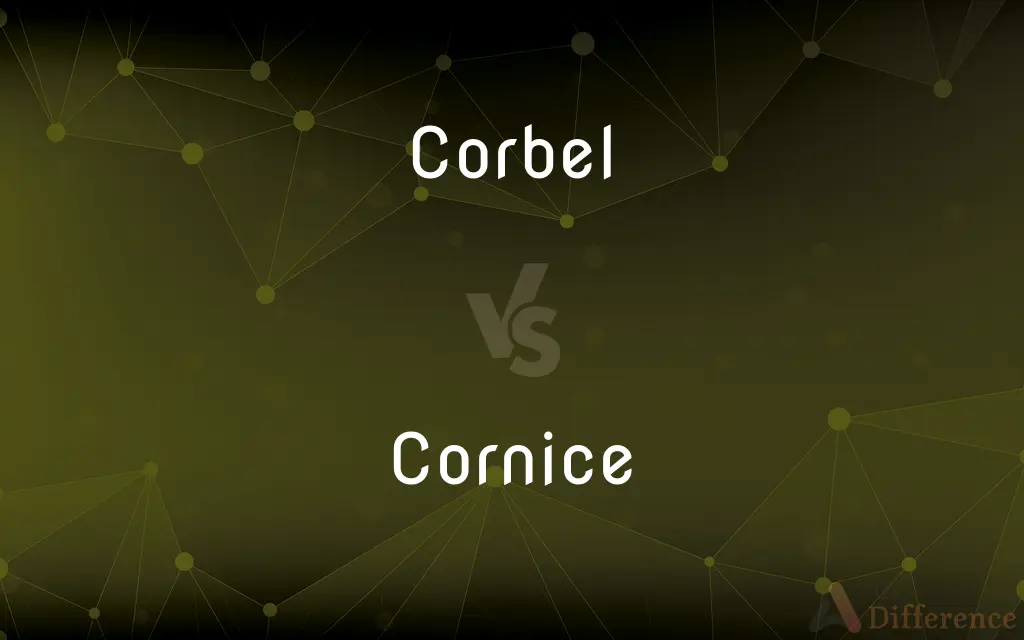Corbel vs. Cornice — What's the Difference?
By Tayyaba Rehman & Urooj Arif — Updated on March 9, 2024
Corbel is a projecting stone bracket supporting weight, whereas cornice is a decorative molding along a wall's top edge.

Difference Between Corbel and Cornice
Table of Contents
ADVERTISEMENT
Key Differences
Corbels have been historically used as structural elements to support projecting features like balconies or arches, offering both functional support and decorative appeal. On the other hand, cornices are primarily decorative elements that crown a building or room, running along the top of walls or above windows and doors.
While corbels serve a practical purpose in addition to their aesthetic value, cornices are largely ornamental, designed to enhance the visual appeal of a building's exterior or an interior room's perimeter. Cornices can be made from various materials, including wood, plaster, or stone, and often feature intricate moldings or patterns to add a finishing touch to a space.
Corbels can be seen in many historical buildings, where they often support significant weight and add to the architectural interest of the structure. They are a testament to the engineering and artistic skills of past eras. Cornices, in contrast, play a crucial role in defining the architectural style and era of a building. They can signify wealth and sophistication, or they can be simple and understated, contributing to the overall aesthetic without overwhelming it.
Comparison Chart
Function
Provides structural support
Decorative molding at the top edge of a wall
Location
Projects from wall to support weight above
Runs along the top edge of a wall or building
ADVERTISEMENT
Material
Stone, wood, or metal
Wood, plaster, stone, or metal
Design
Can be ornately carved or simple
Often features intricate moldings or patterns
Architectural Role
Structural and decorative
Primarily decorative
Compare with Definitions
Corbel
Often ornate, doubling as architectural art.
The ornate corbels added an artistic flair to the otherwise stark fortress.
Cornice
Enhances the aesthetic appeal of a building.
The cornice subtly highlighted the Victorian architecture of the house.
Corbel
A structural piece jutting from a wall to carry a weight.
The ancient corbel was carved with medieval motifs.
Cornice
A decorative molding along the top of a wall.
The gold-leaf cornice added a touch of elegance to the room.
Corbel
A support for a balcony or arch.
Corbels were strategically placed to ensure the archway’s stability.
Cornice
Made from materials like wood, plaster, or stone.
Plaster cornices were meticulously crafted to match the historical era.
Corbel
Made of stone, wood, or metal for supporting structures.
Stone corbels were common in Gothic architecture.
Cornice
Reflects architectural styles and periods.
The simple cornice was indicative of the minimalist modern movement.
Corbel
An architectural bracket projecting from under a cornice.
The corbel under the balcony added both support and decoration.
Cornice
The uppermost section of moldings in a classical entablature.
The building's facade was crowned with an elaborate cornice.
Corbel
In architecture, a corbel is a structural piece of stone, wood or metal jutting from a wall to carry a superincumbent weight, a type of bracket. A corbel is a solid piece of material in the wall, whereas a console is a piece applied to the structure.
Cornice
In architecture, a cornice (from the Italian cornice meaning "ledge") is generally any horizontal decorative moulding that crowns a building or furniture element – the cornice over a door or window, for instance, or the cornice around the top edge of a pedestal or along the top of an interior wall. A simple cornice may be formed just with a crown, as in crown moulding atop an interior wall or above kitchen cabinets or a bookcase.
Corbel
A piece of stone, wood, brick, or other building material, projecting from the face of a wall and generally used to support a cornice or arch.
Cornice
A horizontal molded projection that crowns or completes a building or wall.
Corbel
To provide with or support by a corbel or corbels.
Cornice
The uppermost part of an entablature.
Corbel
(architectural element) A structural member jutting out of a wall to carry a superincumbent weight.
Cornice
A strip of molding that runs along the upper part of a wall just below the ceiling.
Corbel
(transitive) To furnish with a corbel or corbels; to support by a corbel; to make in the form of a corbel.
Cornice
An ornamental horizontal molding or frame used to conceal rods, picture hooks, or other devices.
Corbel
A bracket supporting a superincumbent object, or receiving the spring of an arch. Corbels were employed largely in Gothic architecture.
Cornice
An overhanging mass of windblown snow on a ridge or the crest of a mountain.
Corbel
To furnish with a corbel or corbels; to support by a corbel; to make in the form of a corbel.
Cornice
To supply, decorate, or finish with or as if with a cornice.
Corbel
(architecture) a triangular bracket of brick or stone (usually of slight extent)
Cornice
(architectural element) A horizontal architectural element of a building, projecting forward from the main walls, originally used as a means of directing rainwater away from the building's walls.
Corbel
Furnish with a corbel
Cornice
A decorative element applied at the topmost part of the wall of a room, as with a crown molding.
Cornice
A decorative element at the topmost portion of certain pieces of furniture, as with a highboy.
Cornice
An overhanging edge of snow on a ridge or the crest of a mountain and along the sides of gullies.
Cornice
(transitive) To furnish or decorate with a cornice.
Cornice
Any horizontal, molded or otherwise decorated projection which crowns or finishes the part to which it is affixed; as, the cornice of an order, pedestal, door, window, or house.
Cornice
A decorative framework to conceal curtain fixtures at the top of a window casing
Cornice
A molding at the corner between the ceiling and the top of a wall
Cornice
The topmost projecting part of an entablature
Cornice
Furnish with a cornice
Common Curiosities
Where is a cornice located?
A cornice is located along the top edge of a wall or building.
Are corbels found in modern architecture?
Yes, corbels are found in modern architecture, often as decorative elements.
Can corbels be purely decorative?
Yes, corbels can be purely decorative, especially in modern architecture.
Can cornices be custom-made?
Yes, cornices can be custom-made to suit specific architectural styles or personal tastes.
How do corbels and cornices contribute to historical architecture?
They both add architectural detail and function, reflecting the style and technology of their time.
Are there different styles of corbels?
Yes, there are various styles of corbels, ranging from simple to highly ornate, depending on their architectural period and purpose.
What is a corbel used for?
A corbel is used to provide structural support and can also serve decorative purposes.
Do cornices have any structural function?
Cornices are primarily decorative and do not typically serve a structural function.
How do you maintain a cornice?
Maintenance of a cornice involves regular cleaning and, if necessary, restoration to preserve its appearance and material integrity.
What materials are used to make cornices?
Cornices can be made from wood, plaster, stone, or metal.
Can cornices be found in interior design?
Yes, cornices are often used in interior design to add decorative detail along the tops of rooms.
How do corbels contribute to architectural design?
Corbels add both support and decorative detail, contributing to the architectural interest and integrity of a structure.
How does the design of a cornice affect a building's appearance?
The design of a cornice can greatly influence a building's appearance, adding character and style.
Is there a difference in the materials used for corbels and cornices?
Both can be made from similar materials, but their use and design may influence the choice of material.
Can a cornice be added to an existing building?
Yes, a cornice can be added to enhance or change the aesthetic appeal of an existing building.
Share Your Discovery

Previous Comparison
Document vs. Report
Next Comparison
Reclusive vs. SeclusiveAuthor Spotlight
Written by
Tayyaba RehmanTayyaba Rehman is a distinguished writer, currently serving as a primary contributor to askdifference.com. As a researcher in semantics and etymology, Tayyaba's passion for the complexity of languages and their distinctions has found a perfect home on the platform. Tayyaba delves into the intricacies of language, distinguishing between commonly confused words and phrases, thereby providing clarity for readers worldwide.
Co-written by
Urooj ArifUrooj is a skilled content writer at Ask Difference, known for her exceptional ability to simplify complex topics into engaging and informative content. With a passion for research and a flair for clear, concise writing, she consistently delivers articles that resonate with our diverse audience.
















































